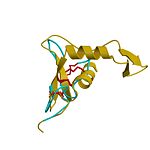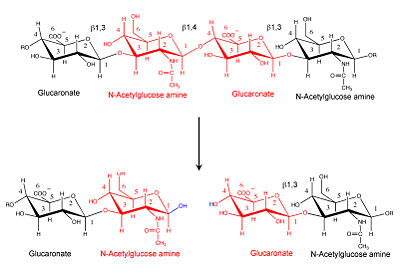Hyaluronidase
From Proteopedia
(Difference between revisions)
| Line 3: | Line 3: | ||
== Function == | == Function == | ||
'''Hyaluronidase''' (HU) hydrolyzes complex carbohydrates such as hyaluronan which is part of the extracellular matrix. The hydrolysis increases tissue permeability. | '''Hyaluronidase''' (HU) hydrolyzes complex carbohydrates such as hyaluronan which is part of the extracellular matrix. The hydrolysis increases tissue permeability. | ||
| - | |||
| - | == Relevance == | ||
| - | HU is used in medicine to speed drug delivery. Hyaluronic acid (HUA) is a popular dermal filler material. | ||
{| | {| | ||
|-valign="top" | |-valign="top" | ||
| Line 11: | Line 8: | ||
|[[Image:Hyal reaction.jpg|thumb|right|'''Hyaluronidase cleaves the β1,4-glycosidic bond of the glycosaminoglycan hyaluronan''' |400px]] | |[[Image:Hyal reaction.jpg|thumb|right|'''Hyaluronidase cleaves the β1,4-glycosidic bond of the glycosaminoglycan hyaluronan''' |400px]] | ||
|} | |} | ||
| + | == Relevance == | ||
| + | HU is used in medicine to speed drug delivery. Hyaluronic acid (HUA) is a popular dermal filler material. | ||
| + | |||
| + | == Structural highlights == | ||
| + | HU structure contains an N-terminal, linker and C-terminal domains. The active site is in a cleft in the N-terminal domain. Two HUA molecules are bound in the active site making contacts with some HU residues and multiple contacts with water molecules<ref>PMID:10843845</ref>. | ||
</StructureSection> | </StructureSection> | ||
Revision as of 08:45, 27 March 2016
| |||||||||||
3D structures of hyaluronidase
Updated on 27-March-2016
Reference
Structure of human hyaluronidase-1, a hyaluronan hydrolyzing enzyme involved in tumor growth and angiogenesis., Chao KL, Muthukumar L, Herzberg O, Biochemistry. 2007 Jun 12;46(23):6911-20. Epub 2007 May 16. PMID:17503783
Created with the participation of Osnat Herzberg, Eran Hodis, Joel L. Sussman, Jaime Prilusky.


